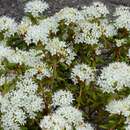en
names in breadcrumbs


Rhododendron groenlandicum (bog Labrador tea, muskeg tea, swamp tea, or in northern Canada, Hudson's Bay tea;[2] formerly Ledum groenlandicum or Ledum latifolium)[3] is a flowering shrub with white flowers and evergreen leaves that is used to make a herbal tea.
It is a low shrub growing to 50 centimetres (20 inches) tall—rarely up to 2 metres (6+1⁄2 feet)—with evergreen leaves 2–6 cm (3⁄4–2+3⁄8 in) long and 3–15 millimetres (1⁄8–5⁄8 in) broad. The leaves are wrinkled on top, densely hairy white to red-brown underneath, and have a leathery texture, curling at the edges. The tiny white flowers grow in hemispherical clusters and are very fragrant and sticky.[4]
Illustration by William Miller
Specimen in Newfoundland and Labrador
It is reported from Greenland, as well as from every province and territory in Canada and in the northeastern and northwestern United States (New England, New York, Pennsylvania, Michigan, Wisconsin, Minnesota, Idaho, Washington, and Alaska).
It grows in bogs, muskegs, and open tundra, as well as occasionally on wet shores and rocky alpine slopes.[5][6]
The plant contains toxic alkaloids which are poisonous to livestock and may be toxic to humans in concentrated doses.[6]
The leaves are regularly used to make beverages and medicines—most commonly a fragrant tea—by many Native American tribes such as the Quinault and Makah, the Potawatomi, the Anishinaabe, the Iroquois, and First Nations tribes in Canada.[6] When European explorers arrived, they soon adopted these uses as well, dubbing it "Indian plant tea".[6] During the American Revolutionary War, it was used as a substitute for tea.[6]
It is sometimes grown as an ornamental shrub.[6]
Its essential oil is popular in aromatherapy.[6]
Rhododendron groenlandicum (bog Labrador tea, muskeg tea, swamp tea, or in northern Canada, Hudson's Bay tea; formerly Ledum groenlandicum or Ledum latifolium) is a flowering shrub with white flowers and evergreen leaves that is used to make a herbal tea.